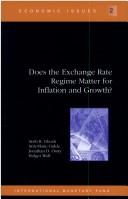| Listing 1 - 4 of 4 |
Sort by
|
Book
ISBN: 1462315607 1455223298 Year: 1991 Publisher: Washington, D.C. : International Monetary Fund,
Abstract | Keywords | Export | Availability | Bookmark
 Loading...
Loading...Choose an application
- Reference Manager
- EndNote
- RefWorks (Direct export to RefWorks)
Real exchange rate variability tends to be higher under flexible than under fixed exchange rates. The neokeynesian view attributes the higher variability to the combination of volatile nominal exchange rates with sticky prices. The neoclassical approach regards an increased incidence of real shocks as the culprit. We test the crucial assumptions underlying the two models for the interwar period. Prices and exchange rates are found to be equally flexible. We hence reject the neokeynesian sticky price view for our sample period. In contrast, our results are consistent with, while not constituting evidence for, the neoclassical equilibrium approach.
Cement --- Ceramics --- Commodities --- Currency --- Deflation --- Exchange rate arrangements --- Exchange rate flexibility --- Exchange rates --- Foreign Exchange --- Foreign exchange --- Glass --- Gold --- Inflation --- International Monetary Arrangements and Institutions --- Investment & securities --- Investments: Metals --- Metals and Metal Products --- Price Level --- Real exchange rates --- United Kingdom
Book
ISBN: 1462394450 1455287806 Year: 1994 Publisher: Washington, D.C. : International Monetary Fund,
Abstract | Keywords | Export | Availability | Bookmark
 Loading...
Loading...Choose an application
- Reference Manager
- EndNote
- RefWorks (Direct export to RefWorks)
Using 1970-85 sectoral data for the OECD we find that inflation in nontradable good exceeds inflation in tradables. We identify a demand shift towards nontradables and faster growth of total factor productivity in the tradable goods sector as the prime causes of the differential inflation. In addition, disinflation attempts and the exchange rate regime appear to have exerted significant influence on the relative inflation rate.
Aggregate Factor Income Distribution --- Capacity --- Capital and Total Factor Productivity --- Cost --- Currency --- Deflation --- Economic Growth of Open Economies --- Exchange rate arrangements --- Expenditure --- Expenditures, Public --- Foreign Exchange --- Foreign exchange --- Income --- Industrial productivity --- Inflation --- Macroeconomics --- Macroeconomics: Production --- National accounts --- National Government Expenditures and Related Policies: General --- Open Economy Macroeconomics --- Price Level --- Prices --- Production and Operations Management --- Production --- Productivity --- Public finance & taxation --- Public Finance --- Total factor productivity --- Belgium
Book
ISBN: 1462304508 1455268704 Year: 1995 Publisher: Washington, D.C. : International Monetary Fund,
Abstract | Keywords | Export | Availability | Bookmark
 Loading...
Loading...Choose an application
- Reference Manager
- EndNote
- RefWorks (Direct export to RefWorks)
The effect of the exchange rate regime on inflation and growth is examined. The 30-year data set includes over 100 countries and nine regime types. Pegged regimes are associated with lower inflation than intermediate or flexible regimes. This anti-inflationary benefit reflects lower money supply growth (a discipline effect) and higher money demand growth (a credibility effect). Output growth does not vary significantly across regimes: Countries with pegged regimes invest more and are more open to international trade than those with flexible rates, but they experience lower residual productivity growth. Output and employment are more variable under pegged rates than under flexible rates.
Conventional peg --- Currency --- Deflation --- Economic Growth of Open Economies --- Exchange rate arrangements --- Exchange rate flexibility --- Exchange rates --- Foreign Exchange --- Foreign exchange --- Inflation --- International Monetary Arrangements and Institutions --- Macroeconomics --- Price Level --- Prices


ISBN: 1557756147 9781455219407 1455219401 9781557756145 1455265055 9781455265053 1455282049 9781455282043 Year: 1996 Publisher: Washington, D.C.
Abstract | Keywords | Export | Availability | Bookmark
 Loading...
Loading...Choose an application
- Reference Manager
- EndNote
- RefWorks (Direct export to RefWorks)
Although the theoretical relationships are ambiguous, evidence suggestsa strong link between the choice of the exchange rate regime and economicperformance. The paper argues that adopting a pegged exchange rate canlead to lower inflation, but also to slower growth in productivity. Itfinds that on average per capita GDP growth was slightly faster underfloating regimes than under pegged exchange regimes.
Economic growth --- International finance --- Foreign Exchange --- Inflation --- Price Level --- Deflation --- Currency --- Foreign exchange --- Macroeconomics --- Exchange rate arrangements --- Exchange rates --- Floating exchange rates --- Conventional peg --- Prices
| Listing 1 - 4 of 4 |
Sort by
|

 Search
Search Feedback
Feedback About UniCat
About UniCat  Help
Help News
News